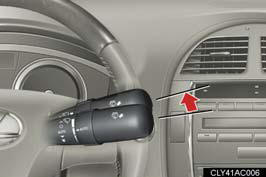Cleaning and protecting the vehicle exterior
Perform the following to protect the vehicle and maintain it in prime condition.
Working from top to bottom, liberally apply water to the vehicle body, wheel wells and underside of the vehicle to remove any dirt and dust.
Wash the vehicle body using a sponge or soft cloth, such as a chamois.
- For hard-to-remove marks, use car wash soap and rinse thoroughly with water.
- Wipe away any water.
- Wax the vehicle when the waterproof coating deteriorates.
If water does not bead on a clean surface, apply wax when the vehicle body is cool.
Automatic car washes
Fold the mirrors back before washing the vehicle.
- Brushes used in automatic car washes may scratch the vehicle surface and harm your vehicle’s paint.
High pressure car washes
Do not allow the nozzles of the car wash to come within close proximity of
the
windows.
- Before car wash, check that the fuel filler door on your vehicle is closed properly.
Touch-up paint (if equipped)
Touch-up paint may be used to cover small chips or scratches.
Apply the paint soon after the damage occurs or corrosion may set in. To apply
the
touch-up paint so it is hardly noticeable the trick is to apply it only to the
bare spots.
Apply only the smallest amount possible and do not paint the surface around the scratch or chip.
Aluminum wheels
Remove any dirt immediately by using a neutral detergent. Do not use hard
brushes
or abrasive cleaners. Do not use strong or harsh chemical cleaners. Use the same
mild detergent and wax as used on the paint.
Bumpers and side moldings
Do not scrub with abrasive cleaners.
To prevent deterioration and body corrosion
Wash the vehicle immediately in the following cases: • After driving near the sea coast.
• After driving on salted roads.
• If you see coal tar or tree sap on the paint surface.
• If you see dead insects or insect droppings on the paint.
• After driving in an area contaminated with soot, oily smoke, mine dust, iron powder or chemical substances.
• If the vehicle becomes heavily soiled in dust or mud.
• If liquids such as benzene and gasoline are spilled on the paint surface.
- If the paint is chipped or scratched, have it repaired immediately.
CAUTION:
Caution about the exhaust pipe
Exhaust gasses cause the exhaust pipe to become quite hot.
When washing the vehicle, be careful not to touch the pipe until it has cooled
sufficiently,
as touching a hot exhaust pipe can cause burns.
NOTICE:
To protect your vehicle’s painted surfaces
Do not use organic cleaners such as benzene or gasoline.
Cleaning the exterior lights - Wash carefully. Do not use organic substances or scrub with a hard brush.
This may damage the surfaces of the lights.
- Do not apply wax on the surfaces of the lights.
Wax may cause damage to the lenses.
When using an automatic car wash (vehicles equipped with the rain-sensing windshield wipers)

Set the wiper switch to the off position.
If the wiper switch is in “AUTO”, the wipers may operate and the wiper blades may be damaged.
See also:
Cleaning and protecting the vehicle exterior
Perform the following to protect the vehicle and maintain it in prime
condition:
l Working from top to bottom, liberally apply water to the vehicle
body, wheel wells and underside of the vehicle t ...
Rear view monitor system (rear view mirror-attached type)
The rear view monitor system assists the driver by displaying an image of
the area behind the vehicle. The image is displayed in reverse on the
screen. This reversed image is a similar image to the ...
RX 350 in the Market
The RX was arguably the first luxury crossover SUV, and this model remains
competitive in a segment that's exploded with new offerings.
It helps that Lexus clearly decided to build a comfortable l ...
